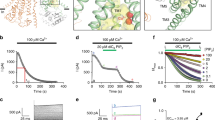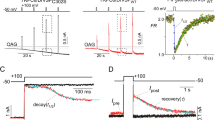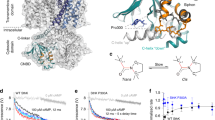Abstract
TRPM7 (ChaK1, TRP-PLIK, LTRPC7) is a ubiquitous, calcium-permeant ion channel that is unique in being both an ion channel and a serine/threonine kinase. The kinase domain of TRPM7 directly associates with the C2 domain of phospholipase C (PLC). Here, we show that in native cardiac cells and heterologous expression systems, Gαq-linked receptors or tyrosine kinase receptors that activate PLC potently inhibit channel activity. Numerous experimental approaches demonstrated that phosphatidylinositol 4,5-bisphosphate (PIP2), the substrate of PLC, is a key regulator of TRPM7. We conclude that receptor-mediated activation of PLC results in the hydrolysis of localized PIP2, leading to inactivation of the TRPM7 channel.
This is a preview of subscription content, access via your institution
Access options
Subscribe to this journal
Receive 12 print issues and online access
$209.00 per year
only $17.42 per issue
Buy this article
- Purchase on Springer Link
- Instant access to full article PDF
Prices may be subject to local taxes which are calculated during checkout








Similar content being viewed by others
References
Runnels, L. W., Yue, L. & Clapham, D. E. TRP-PLIK, a bifunctional protein with kinase and ion channel activities. Science 291, 1043–1047 (2001).
Nadler, M. J. S. et al. LTRPC7 is a Mg·ATP-regulated divalent cation channel required for cell viability. Nature 411, 590–595 (2001).
Duncan, L. M. et al. Melastatin expression and prognosis in cutaneous malignant melanoma. J. Clin. Oncol. 19, 568–576 (2001).
Clapham, D. E., Runnels, L. W. & Strübing, C. The TRP ion channel family. Nature Rev. Neurosci. 2, 387–396 (2001).
Harteneck, C., Plant, T. D. & Schultz, G. From worm to man: three subfamilies of TRP channels. Trends Neurosci. 23, 159–166 (2000).
Montell, C. Physiology, phylogeny, and functions of the TRP superfamily of cation channels. Science STKE (cited 10 Jul 2001) 〈http://stke.sciencemag.org/cgi/content/full/OC_sigtrans;2001/90/re1〉 (2001).
Montell, C. & Rubin, G. M. Molecular characterization of the Drosophila locus: a putative integral membrane protein required for phototransduction. Neuron 2, 1313–1323 (1989).
Niemeyer, B. A., Suzuki, E., Scott, K., Jalink, K. & Zuker, C. S. The Drosophila light-activated conductance is composed of the two channels, TRP and TRPL. Cell 85, 651–659 (1996).
Xu, X. Z., Chien, F., Butler, A., Salkoff, I. & Montell, C. TRPγ, a Drosophila TRP-related subunit, forms a regulated cation channel with TRPL. Neuron 26, 647–657 (2000).
Bloomquist, B. T. et al. Isolation of a putative phospholipase C gene of Drosophila, norpA, and its role in phototransduction. Cell 54, 723–733 (1988).
Hardie, R. C. & Raghu, P. Visual transduction in Drosophila. Nature 413, 186–193 (2001).
Hardie, R. C. et al. Calcium influx via TRP channels is required to maintain PIP2 levels in Drosophila photoreceptors. Neuron 30, 145–159 (2001).
Chyb, S., Padinjat, R. & Hardie, R. C. Polyunsaturated fatty acids activate the Drosophila light-sensitive channels TRP and TRPL. Nature 397, 255–259 (1999).
Hofmann, T. et al. Direct activation of human TRPC6 and TRPC3 channels by diacylglycerol. Nature 397, 259–263 (1999).
Huang, C. L., Feng, S. & Hilgemann, D. W. Direct activation of inward rectifier potassium channels by PIP2 and its stabilization by Gβγ. Nature 391, 803–806 (1998).
Sui, J. L., Petit-Jacques, J. & Logothetis, D. E. Activation of the atrial KACh channel by the βγ subunits of G proteins or intracellular Na+ ions depends on the presence of phosphatidylinositol phosphates. Proc. Natl Acad. Sci. USA 95, 1307–1312 (1998).
Chuang, H.-H. et al. Bradykinin and nerve growth factor release the capsaicin receptor from PtdIns(4,5)P2-mediated inhibition. Nature 411, 957–962 (2001).
Peralta, E. G., Ashkenazi, A., Winslow, J. W., Ramachandran, J. & Capon, D. J. Differential regulation of PI hydrolysis and adenylyl cyclase by muscarinic receptor subtypes. Nature 334, 434–437 (1988).
Ashkenazi, A., Peralta, E. G., Winslow, J. W., Ramachandran, J. & Capon, D. J. Functional diversity of muscarinic receptor subtypes in cellular signal transduction and growth. Trends Pharmacol. Sci. Suppl. 16–22 (1989).
Garcia, P. et al. The pleckstrin homology domain of phospholipase C-δ1 binds with high affinity to phosphatidylinositol 4,5-bisphosphate in bilayer membranes. Biochemistry 34, 16228–16234 (1995).
Stauffer, T. P., Ahn, S. & Meyer, T. Receptor-induced transient reduction in plasma membrane PtdIns(4,5)P2 concentration monitored in living cells. Curr. Biol. 8, 343–346 (1998).
Varnai, P. & Balla, T. Visualization of phosphoinositides that bind pleckstrin homology domains: calcium- and agonist-induced dynamic changes and relationship to myo-[3H]inositol-labeled phosphoinositide pools. J. Cell Biol. 143, 501–510 (1998).
Hirose, K., Kadowaki, S., Tanabe, M., Takeshima, H. & Iino, M. Spatiotemporal dynamics of inositol 1,4,5-trisphosphate that underlies complex calcium mobilization patterns. Science 284, 1527–1530 (1999).
Wu, D., Jiag, H., Katz, A. & Simon, M. I. Identification of critical regions on phospholipase C-β1 required for activation by G proteins. J. Biol. Chem. 268, 3704–3709 (1993).
Berridge, M. J., Lipp, P. & Bootman, M. D. The versatility and universality of calcium signalling. Nature Rev. Mol. Cell Biol. 1, 11–21 (2000).
Clapham, D. E. Calcium signalling. Cell 80, 259–268 (1995).
McLaughlin, S., Wang, J., Gambhir, A. & Murray, D. PIP2 and Proteins: Interactions, organization and information flow. Annu. Rev. Biophys. Biomol. Struct. (In the press).
Oancea, E. & Meyer, T. Protein kinase C as a molecular machine for decoding calcium and diacylglycerol signals. Cell 95, 307–318 (1998).
Oancea, E., Teruel, M. N., Quest, A. F. & Meyer, T. Green fluorescent protein (GFP)-tagged cysteine-rich domains from protein kinase C as fluorescent indicators for diacylglycerol signalling in living cells. J. Cell Biol. 140, 485–498 (1998).
Wakelam, M. J. O. Diacylglycerol - when is it an intracellular messenger? Biochim. Biophys. Acta 1436, 117–126 (1998).
Nakanishi, S., Catt, K. J., & Balla, T. A wortmannin-sensitive phosphatidylinositol 4-kinase that regulates hormone-sensitive pools of inositol phospholipids. Proc. Natl Acad. Sci. USA 92, 5317–5321 (1995).
Downing, G. J., Kim, S., Nakanishi, S., Catt, K. J., & Balla, T. Characterization of a soluble adrenal phosphatidylinositol 4-kinase reveals wortmannin sensitivity of type III phosphatidylinositol kinases. Biochemistry 35, 3587–3594 (1996).
Willars, G. B., Nahorski, S. R., & Challis, R. A. J. Differential regulation of muscarinic acetylcholine receptor-sensitive polyphosphoinositide pools and consequences for signalling in human neuroblastoma cells. J. Biol. Chem. 273, 5037–5046 (1998).
Xie, L.-H., Horie, M. & Takano, M. Phospholipase C-linked receptors regulate the ATP-sensitive potassium channel by means of phosphatidylinositol 4,5-bisphosphate metabolism. Proc. Natl Acad. Sci. USA 96, 15292–15297 (1999).
Broad, L. M. et al. Role of the phospholipase C-inositol 1,4,5-trisphosphate pathway in calcium release-activated calcium current and capacitative calcium entry. J. Biol. Chem. 276, 15945–15952 (2001).
Cho, H., Nam G.-B., Lee, S. H., Earm, Y. E., & Ho, W.-K. Phosphatidylinositol 4,5-bisphosphate is acting as a signal molecule in α1-adrenergic pathway via the modulation of acetylcholine-activate K+ channels in mouse atrial myocytes. J. Biol. Chem. 276, 159–164 (2001).
Margolis, B. et al. EGF induces tyrosine phosphorylation of phospholipase C-II: a potential mechanism for EGF receptor signalling. Cell 57, 1101–1107 (1989).
Cochet, C., Filhol, O., Payrastre, B. Hunter, T., & Gill, G. N. Interaction between the epidermal growth factor receptor and phosphoinositide kinases. J. Biol. Chem. 266, 637–644 (2001).
Thomas, C. L., Steel, J., Prestwich, G. D. & Schiavo, G. Generation of phosphatidylinositol-specific antibodies and their characterization. Biochem. Soc. Trans. 27, 648–652 (1999).
Fukami, K. et al. Antibody to phosphatidylinositol 4,5-bisphosphate inhibits oncogene-induced mitogenesis. Proc. Natl Acad. Sci. USA 85, 9057–9061 (1988).
Moolenaar, W. H. et al. Growth factor-like action of phosphatidic acid. Nature 323, 171–173 (1986).
Van Corven, E. J., Groenink, A., Jalink, K., Eichholtz, & Moolenaar, W. H. Lysophosphatidate-induced cell proliferation identification and dissection of signalling pathways mediated by G proteins. Cell 59, 45–54 (1989).
Moolenaar, W. H. Bioactive lysophospholipids and their G protein-coupled receptors. Exp. Cell Res. 252, 230–238 (1999).
Ishii, I., Contos, J. J. A., Fukushima, N., & Chun, J. Functional comparisons of the lysophosphatidic acid receptors, LPA1/VZG-1/EDG-2, LPA2/EDG-4, and LPA3/EDG-7 in neuronal cell lines using a retrovirus expression system. Mol. Pharmacol. 58, 895–902 (2000).
Contos, J. J. A., Ishii, I., & Chun, J. Lysophosphatidic acid receptors. Molecular Pharmacology. 58, 1188–1196 (2000).
Romani, A. M. P. & Scarpa, A. Regulation of cellular magnesium. Front. Biosci. 5, 7210–7734 (2000).
Harman, A. W., Nieminen, A.-L., Lemasters, J. J., & Herman, B. Cytosolic free magnesium, ATP, and blebbing during chemical hypoxia in cultured rat hepatocytes. Biochem. Biophys. Res. Commun. 170, 477–483 (1990).
Hilgemann, D. W., Feng, S., & Nasuhoglu, C. The complex and intriguing lives of PIP2 with ion channels and transporters. Science STKE (cited 04 December 2001) 〈http:/stke.sciencemag.org/cgi/content/full/OC_sigtrans;2001/111/re19〉 (2001).
Morris, A. J. One wheel on my wagon: lysolipid phosphate signalling. Trends Pharmacol. Sci. 20, 393–395 (1999).
Rebecchi, M. J. & Pentyala, S. N. Structure, function, and control of phosphoinositide-specific phospholipase C. Physiol. Rev. 80, 1291–1335 (2000).
Acknowledgements
We thank S. Goo Rhee for PLC-β4 and PLC-γ1 cDNAs, M. Rebecchi for expression plasmids containing PLC-δ1 and the PH domain of PLC-δ1, and E. Oancea for the C12–GFP and GFP-tagged PLC-δ1 expression constructs. We also thank Q. Shi for her technical advice in culturing ventricular fibroblasts and L. Cantley, C. Carpenter, A. Morris and S. McLaughlin for helpful discussions. L.Y. was supported by the Heart and Stroke Foundation of Canada.
Author information
Authors and Affiliations
Corresponding author
Ethics declarations
Competing interests
The authors declare no competing financial interests.
Rights and permissions
About this article
Cite this article
Runnels, L., Yue, L. & Clapham, D. The TRPM7 channel is inactivated by PIP2 hydrolysis. Nat Cell Biol 4, 329–336 (2002). https://doi.org/10.1038/ncb781
Received:
Revised:
Accepted:
Published:
Issue Date:
DOI: https://doi.org/10.1038/ncb781
This article is cited by
-
Adipose-specific deletion of the cation channel TRPM7 inhibits TAK1 kinase-dependent inflammation and obesity in male mice
Nature Communications (2023)
-
TRP Channels in Stroke
Neuroscience Bulletin (2023)
-
Butyrate reduces cellular magnesium absorption independently of metabolic regulation in Caco-2 human colon cells
Scientific Reports (2022)
-
Structural mechanism of TRPM7 channel regulation by intracellular magnesium
Cellular and Molecular Life Sciences (2022)
-
TRPM7 channel activity in Jurkat T lymphocytes during magnesium depletion and loading: implications for divalent metal entry and cytotoxicity
Pflügers Archiv - European Journal of Physiology (2020)



